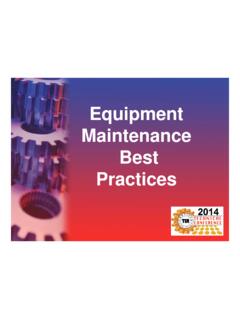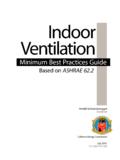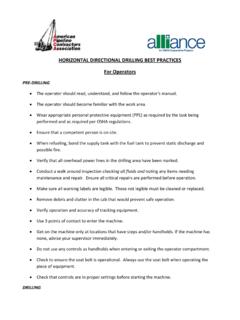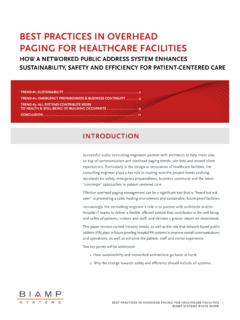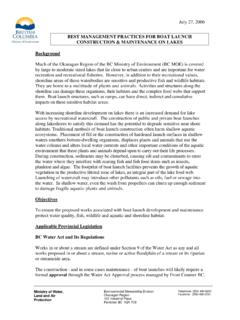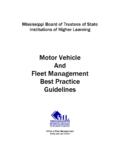Transcription of Best Management Practices For Industrial Storm …
1 best Management Practices For Industrial Storm Water Pollution Control Sacramento Stormwater Management Program 1 CONTENTS Introduction Part I: Recommended BMPs Section Industrial Activity 1. Training and Education for Employees and Customers 2. Eliminating Improper Discharges to Storm Drains 3. Spill Prevention, Control, and Cleanup 4. Outdoor Process Equipment Operations and Maintenance 5. Outdoor Materials Storage and Handling 6. Waste Handling and Disposal 7. Vehicle and Equipment Washing and Steam Cleaning 8. Trucking and Shipping/Receiving 9. Fleet Vehicle Maintenance 10. Fueling Fleet Vehicles and Equipment 11. Building and Grounds Maintenance 12. Building Repair, Remodeling, and Construction Part 2: Advanced BMPs and Structural Controls Section Advanced or Structural Control 13.
2 Loading Dock Design Features 14. Equipment Yard Design Features 15. Fleet or Equipment Fueling Area Design Features 16. Access Roads and Rail Corridors 17. Onsite Storm Water Management 18. Redirect Discharge from Storm Drain to Sanitary Sewer 19. Storm Water Management : Hydraulic Controls 20. Storm Water Management : Water Quality Controls 21. Storm Water Management : Removing Oily Contaminants The Sacramento Stormwater Management Program gratefully acknowledges the Santa Clara Valley Urban Runoff Pollution Prevention Program, which graciously granted permission to use the content of its original publication. The original publication from which this is adapted is best Management Practices of Industrial Storm Water Pollution Control , created by Woodward-Clyde Consultants: L.
3 D. Duke, J. A Shannon, June 1992. Design and illustrations: by John Finger, Finger Art & Design. 2 Introduction: Storm Water Pollution Control for Industrial Facilities Contaminated stormwater is a source of pollutants in the Sacramento creeks and rivers. Storm drains carry runoff from streets, urban centers, Industrial sites, and open spaces into streams, creeks, and rivers. Industrial operations are only one contributor to this problem, but they are known to be a source of heavy metals, oily wastes, and other substances. Manufacturing, shipping, and storage operations that are exposed to Storm water can be sources of pollutants in Storm water. Federal and state Storm water regulations now require many kinds of Industrial facilities to take steps to prevent Storm water pollution.
4 Based upon SIC codes and stormwater exposure, your facility may need to be covered under the General Industrial Stormwater Permit. If so, you need to prepare a Storm Water Pollution Prevention Plan, or SWPPP, that is in part a collection of best Management Practices (BMPs are pollution control measures) like the ones described in this manual. if your facility is not covered under the General Permit, you will still need to implement BMPs to comply with local stormwater ordinances. Storm water pollution, unlike some pollution problems, cannot be covered by one set of rules that applies to all Industrial facilities. Regulated Industrial facilities in Sacramento County range from manufacturing facilities covering several square miles to storefront distributors. Different plants can have very different Storm water quantities, flow patterns, and potential pollutants.
5 Even different facilities of the same general industry may need different approaches to preventing Storm water pollution. The BMPs in this manual are recommended by the Sacramento County Stormwater Program to help you prevent Storm water pollution at your commercial or Industrial facility; protect water quality in local creeks and streams, the groundwater basin, and rivers; and comply with Storm water regulations. This manual is intended to help you identify and implement effective and economical measures for your facility. BMPs include both operating Practices and structural controls that can reduce the amounts of pollutants in Storm water. You need to determine which of these may apply to your facility, and implement them as necessary. Specific regulations may vary from one municipality to another, so you should become familiar with local Storm water ordinances in your community.
6 Most cities within Sacramento County have their own Stormwater Ordinances. This manual consists of two parts. The recommended BMPs in Part 1 are basic, everyday operational Practices and relatively small structural or equipment requirements that can be effective in preventing pollution, reducing potential pollutants at the source. In many Industrial facilities, Storm water pollution can be prevented with common-sense precautions and modest changes in routine operations or maintenance Practices . The numbered sections are keyed to some Industrial operations that are common to many kinds of facilities. The sections describe BMPs that typically can be applied to the operations. These Practices alone might be sufficient to control Storm water pollution for some Industrial facilities.
7 In other cases, to prevent Storm water pollution it will be necessary to establish new Practices or build physical controls. Part 2 of this manual consists of "advanced Management Practices ." The advanced BMPs require more costly or more intensive efforts to address pollutants that are not adequately controlled by the simpler operational BMPs. The advanced BMPs describe possible approaches if you need to go beyond the Part 1 BMPs. Businesses operating in Sacramento County should be aware that in addition to the State s General Industrial Stormwater Permit which applies to certain industries such as manufacturing, mining, recycling, auto dismantlers, cement plants and hazardous waste treatment, storage and disposal facilities, all businesses must also comply with County and city stormwater Ordinances.
8 For a copy of the County s Stormwater Ordinance Fact Sheet call Sacramento County s Department of Water Resources at (916) 874-6851. Businesses should also be aware that the County has been required to by the State of California to begin conducting stormwater pollution compliance inspections at area businesses. Affected businesses include restaurants, gas stations, auto body and repair facilities, nurseries, equipment rental yards, auto dealers and General Industrial Stormwater Permit facilities. Inspections begin July, 2004. 3 Recommended BMPs for Storm Water Pollution Prevention Part 1 of this manual contains BMPs that are recommended to control Storm water pollution from particular Industrial activities. Part 1 is divided into numbered sections. Each section describes Industrial activities common to many kinds of Industrial facilities, and contains a collection of BMPs tailored to that kind of Industrial activity or operation.
9 As a rule the recommended BMPs in this part of the manual are intended to describe "state of the practice." These are the preferred operational techniques that pertain to each of the Industrial activities, recom-mended to control potential Storm water pollution that could result from that activity. Many of these Practices are straightforward housekeeping activities, and many may already be in place at your facility. In general, the recommended BMPs are pollution prevention measures: they are geared toward reducing pollutants at the source in order to prevent the release of potential pollutants to Storm water. The recommended BMPs are to be implemented on an ongoing basis for the indefinite future. Operators of Industrial and commercial facilities should expect to implement these BMPs or similar controls, wherever they would be effective at preventing pollutants from flowing with Storm water from the site.
10 Review your current operating Practices and, where they differ from the Part 1 preferred BMPs, modify your Practices and train your employees in the new procedures. You need to evaluate your own facility and decide what works best , because Storm water pollution control Practices take a number of forms, and may include a wide range of solutions that are not included in this manual. Storm water pollution control may be guided by three general principles: 1) Prevent water from contacting working areas. Shipping areas, outdoor equipment, material storage areas, vehicle maintenance spaces, and working areas of all sorts are subject to contamination with raw materials, process liquids, grease, oily wastes, Vehicle fluids, heavy metals, and miscellaneous potential pollutants.

